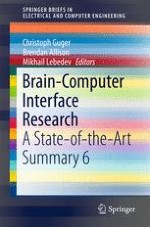2017 | Buch
Brain-Computer Interface Research
A State-of-the-Art Summary 6
herausgegeben von: Dr. Christoph Guger, Dr. Brendan Allison, Ph.D. Mikhail Lebedev
Verlag: Springer International Publishing
Buchreihe : SpringerBriefs in Electrical and Computer Engineering
